|
|
|
Sort Order |
|
|
|
Items / Page
|
|
|
|
|
|
|
| Srl | Item |
| 1 |
ID:
152671
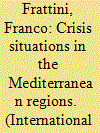

|
|
|
|
|
| Summary/Abstract |
I WOULD START with the analysis of a topic that we could consider crucial: what is happening along the borders of Italy's southern coast? Analysts who spoke of "world disorder" with reference to the events, which are currently taking place in the Mediterranean region, probably used the most appropriate definition. If we think that last year we celebrated the anniversary of the Yalta Treaty - the 1945 conference that gave rise to a new "world order" - and that after seventy years, with the explosion of different trouble spots all over the world, we should almost go back to talking of "disorder," that idea makes me smile. That scenario was evoked several times, even in the Holy Father's words, when a few years ago, returning from a mission to South Korea, he said: "We entered the Third World War: only it is being fought in pieces, in chapters."
|
|
|
|
|
|
|
|
|
|
|
|
|
|
|
|
| 2 |
ID:
141680
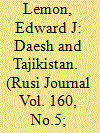

|
|
|
|
|
| Summary/Abstract |
The threat of radical Islam has been used by the Tajik government as a way to promote discriminatory policies based on a misinterpretation of the causes and extent of radicalisation in the country, argues Edward J Lemon. He analyses the Tajik government's rhetoric and policies to show how it has created a situation of insecurity for the country's citizens.
|
|
|
|
|
|
|
|
|
|
|
|
|
|
|
|
| 3 |
ID:
164600
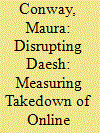

|
|
|
|
|
| Summary/Abstract |
This article contributes to public and policy debates on the value of social media disruption activity with respect to terrorist material. In particular, it explores aggressive account and content takedown, with the aim of accurately measuring this activity and its impacts. The major emphasis of the analysis is the so-called Islamic State (IS) and disruption of their online activity, but a catchall “Other Jihadi” category is also utilized for comparison purposes. Our findings challenge the notion that Twitter remains a conducive space for pro-IS accounts and communities to flourish. However, not all jihadists on Twitter are subject to the same high levels of disruption as IS, and we show that there is differential disruption taking place. IS’s and other jihadists’ online activity was never solely restricted to Twitter; it is just one node in a wider jihadist social media ecology. This is described and some preliminary analysis of disruption trends in this area supplied too.
|
|
|
|
|
|
|
|
|
|
|
|
|
|
|
|
| 4 |
ID:
157743
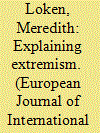

|
|
|
|
|
| Summary/Abstract |
Women participate extensively in armed, Islamist struggle. In recent years, foreign women have travelled from the West to join Daesh. Their participation perplexes policymakers, government officials, and researchers who call attention to the group’s gendered regulation, violence, and widespread use of rape. Consequently, observers often argue that women are deceived by the organisation or seduced by the promise of romance. This suggests that women would not, under rational circumstances, choose to join the group. In this article, we address two resultant questions: why do Western women join Daesh? Are their motivations distinct from other Islamist recruits? Using an original dataset of social media activity from 17 Western female recruits between 2011–15, we conclude that women are primarily driven by religious ideology that adopts an expressly gendered frame. We find that feelings of isolation and disaffection also drive migration. We suggest that female foreign recruits are not unique in their motivations and share many similarities with male fighters and women in other Islamist organisations. This research has valuable implications for security studies and counterterrorism, which tend to treat extremist women as unique. Female recruits should be taken seriously as insurgents intent on establishing an Islamic caliphate.
|
|
|
|
|
|
|
|
|
|
|
|
|
|
|
|
| 5 |
ID:
174379
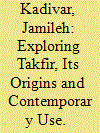

|
|
|
|
|
| Summary/Abstract |
Muslims have been the primary targets of Daesh’s attacks since 2014 in different countries such as Afghanistan, Iraq, and Syria. These attacks were based on its takfiri ideology. As Daesh official media and documents indicate, kufr (unbelief, infidelity) in Daesh’s approach is not limited to non-Muslims (original disbelievers), but Muslims are the most significant parts of kuffar (unbelievers) in its view and defined as incidental disbelievers. Through studying Daesh’s official documents and various Arabic, English, and Persian media productions, in an explanatory research, this article attempts to display Daesh’s takfiri approach toward Muslims and explains its historical and ideological roots, difference with Al-Qaeda’s takfiri approach, different approaches to takfir inside Daesh, main targets of Daesh’s takfir, and the reasons behinds its takfiri view. This article displays that for Daesh, the Muslims are limited only to Sunni Muslims who are accepting and following its approach. Other Sunni and non-Sunni Muslims are thus kuffar. This study also shows that the assertion of takfir has become a method for Daesh to discredit its opponents, such as Shi’a Muslims and other Muslim groups.
|
|
|
|
|
|
|
|
|
|
|
|
|
|
|
|
| 6 |
ID:
187009
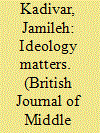

|
|
|
|
|
| Summary/Abstract |
Since its inception, Daesh has been regarded as a powerful actor by pundits, journalists, and politicians. This paper’s primary aim is to show how, and by what cultural means, Daesh became so powerful, and to study what lies behind its non-coercive power. This paper is part of an ongoing research project designed to study the different aspects of Daesh’s power. Drawing on Gramsci’s ‘hegemonic power,’ and Bourdieu’s ‘cultural capital’, the research explains what it is in Daesh’s cultural power that creates consent. In doing so, this study examines the various English and Arabic content of Daesh’s official media and the documents it has released since June 2014. Additionally, data has been collected from 19 semi-structured expert interviews together with other secondary sources. The findings of the study show that Daesh’s power goes beyond its coercive power. This research acknowledges that Daesh’s ideology is central to its power and is present in all aspects of the Khilafah’s activities, including in its multi-faceted power (i.e., its cultural, media, political and economic power).
|
|
|
|
|
|
|
|
|
|
|
|
|
|
|
|
| 7 |
ID:
142174
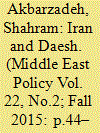

|
|
|
|
|
| Summary/Abstract |
President Hassan Rouhani came to office in 2014 with a popular mandate to relieve Iran's international isolation. His electoral campaign focused on ending the crippling sanctions Iran has suffered due to the ongoing dispute over its nuclear program. Rouhani promised to make “moderation” the centerpiece of his government, but breaking out of isolation has proven to be much more difficult than the reform-inclined Rouhani government expected. The Arab upheaval has morphed into sectarian warfare, championed by the Islamic State of Iraq and Syria (“Daesh” in Arabic and Persian). This conflict has presented Iran with a most unwanted problem. From its inception, Iran has projected itself as a champion of the whole Muslim community. It has stayed clear of sectarian disputes with its Sunni neighbors and presented its disagreements with Saudi Arabia, for example, in terms of global Muslim interests. It highlighted the failure of U.S.-friendly Arab leaders to protect the Palestinians as the cardinal charge against them. Their Sunni affiliation was not the issue. However, the bloody sectarian conflict in Iraq and Syria, with spot fires in other states, has forced Iran to engage with the sectarian issue. Events of the past few years have made it impossible for Iran to ignore the schism. This complicates President Rouhani's task: his promised mantra of “prudence and hope” (tadbir va omid) has effectively been sidelined in the context of forming a Daesh policy. Iran is forced into relying on its Shia allies to respond to the threat posed by Daesh, making Iran a reluctant Shia power in the region.
|
|
|
|
|
|
|
|
|
|
|
|
|
|
|
|
| 8 |
ID:
147723
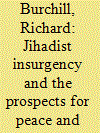

|
|
|
|
|
| Summary/Abstract |
Modern jihadist insurgency movements pose a threat to global peace and security. Modern jihadist insurgencies are not necessarily posing new operational challenges, instead it is the ideology and belief systems justifying the use of violence that we need to understand better. The ideology fuelling modern jihadist insurgencies, motivating the fighters, acting as a tool for recruiting and support is the key strength these groups have and the one area we have yet to adequately address. We must work to better understand this ideology and how it is utilised otherwise the threat from violent jihadist movements may continue for a very long time.
|
|
|
|
|
|
|
|
|
|
|
|
|
|
|
|
| 9 |
ID:
166660
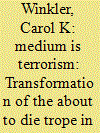

|
|
|
|
|
| Summary/Abstract |
Daesh’s ability to successfully recruit foreign fighters from more than one hundred countries worldwide raises the importance of understanding the group’s strategic media campaign. Recognizing that visual images, in particular, often increase viewers’ attention, recall, and emotional response, this study of Daesh’s official magazine, Dabiq, moves beyond earlier studies primarily focused on the magazine’s textual content to analyze the group’s visual communication strategy. This study’s content analysis of the 1,144 images appearing in the magazine’s first twelve issues reveals how Dabiq has relied extensively on a historic American media trope, the about to die image, to bolster image recirculation over time. This essay examines both the form and content of Dabiq’s use of three about to die image types as they have evolved across the twelve issues. Rather than seek to win the “hearts and minds” of the Muslim public, Dabiq’s use of about to die images transforms the online medium into terrorism in ways that have lasting implications for the global culture.
|
|
|
|
|
|
|
|
|
|
|
|
|
|
|
|
| 10 |
ID:
154976


|
|
|
|
|
| Summary/Abstract |
Daesh fighters have taken hostage over 100 foreigners in Syria, Iraq, and elsewhere since 2012. The kidnappings drew international attention in August 2014, when American journalist James Foley was decapitated and a video of his death was posted online. But the pattern of kidnappings and gruesome videos distributed by violent Salafi-jihadists extends back over a decade to the killing of Daniel Pearl in 2002. This article traces shifts in the strategic rationale of Al Qaeda and Daesh for beheading Western hostages. It argues that terrorists altered their calculations on foreign hostages beginning in 2012 and U.S. counterterrorism policy does not take these shifts into account.
|
|
|
|
|
|
|
|
|
|
|
|
|
|
|
|
| 11 |
ID:
184342
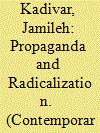

|
|
|
|
|
| Summary/Abstract |
The process of becoming radicalized and joining extremist groups like Daesh, in countries with a Shi’a majority, such as Iran, is a controversial topic that has not received sufficient attention in the literature. This study examines Daesh’s media content in Farsi and seeks to provide an analysis of Daesh’s main messages, which have the primary objective of profoundly impacting their target audiences in Iran. This study collected data from 16 Iranian members of Daesh to discover how they were radicalized and why they decided to join Daesh. This study seeks to understand whether the media and Daesh’s propaganda are indeed the key reasons behind the radicalization of Daesh’s Iranian members and the creation of others’ perception of their mindsets against Iran and its Shi’a population, and to discover other possible factors that play a role in the radicalization process. While Daesh media and messages hold salience in relation to the Daeshization of some, studying such complex socio-political issues is rooted in an amalgamation of different personal, social, political, economic, and cultural push and pull factors. Such phenomena cannot, therefore, be reduced to only one of the mentioned elements.
|
|
|
|
|
|
|
|
|
|
|
|
|
|
|
|
| 12 |
ID:
159365
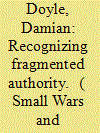

|
|
|
|
|
| Summary/Abstract |
The rollback of Daesh’s territorial control during 2017 has (re-)established an area of limited statehood in large parts of Iraq that may endure for many years. The government of Iraq projects its authority into a large geographical and political space that it shares with a multitude of other state, non-state and hybrid actors, competing and collaborating to achieve advantageous security and political outcomes. This paper examines the heterarchy of actors in post-Daesh Iraq to develop a typology and start a critical discussion about post-Westphalian alternatives for security governance in Iraq during the coming period of reconstruction and reconciliation.
|
|
|
|
|
|
|
|
|
|
|
|
|
|
|
|
| 13 |
ID:
170072
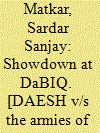

|
|
|
|
|
| Publication |
Mumbai, FINS, 2015.
|
| Description |
202p.pbk
|
|
|
|
|
|
|
|
|
|
|
|
Copies: C:1/I:0,R:0,Q:0
Circulation
| Accession# | Call# | Current Location | Status | Policy | Location |
| 059804 | 303.625/MAT 059804 | Main | On Shelf | General | |
|
|
|
|
| 14 |
ID:
148022


|
|
|
|
|
| Summary/Abstract |
Terrorism and violent extremism are usually the top national security risks amongst the five Central Asian states. Although each state has its own approach to countering violent extremism and terrorism, they tend to broadly agree on the nature of the threat. Their definitions of “terrorism” and “extremism” are relatively broad in both legal definition and in practice, and they are often geared towards protecting the political and social status quo. A key challenge is that both religion and religiously-inclined, usually Islamic, groups have become blanket tools of blame to cover a range of actions and the perceived threat of actions deemed “terrorist” and “extremist”.
|
|
|
|
|
|
|
|
|
|
|
|
|
|
|
|
| 15 |
ID:
173844
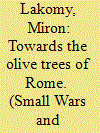

|
|
|
|
|
| Summary/Abstract |
This paper aims to contribute to understanding how the last flagship magazine of the Islamic State - “Rumiyah” - attempted to influence and manipulate Internet users. Its primary objective is to analyze the propaganda methods exploited in all thirteen issues of this magazine. In order to do so this paper utilises content analysis to investigate “propaganda devices”, a concept developed by the American Institute for Propaganda Analysis. It argues that there were four predominant groups of propaganda devices exploited in this magazine. Two of them, i.e. name-calling and glittering generalities, were utilized to create and promote an artificial, black-and-white vision of the world, composed of the “camp of kufr” (camp of disbelief) and the “camp of iman” (camp of faith), embodied by the Islamic State. The third leading propaganda method, transfer, attempted to legitimize the actions and agenda of the “Caliphate” by using the authority of not only Allah, but also the Prophet Muhammad, his companions (Sahabah), as well as selectively chosen Islamic scholars. Finally, the bandwagon served as a means of creating a sense of community between the editors and readers. Other propaganda devices, such as testimonial or plain folks, played strictly secondary roles in the narration of the magazine.
|
|
|
|
|
|
|
|
|
|
|
|
|
|
|
|
| 16 |
ID:
142935
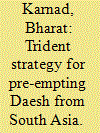

|
|
|
| 17 |
ID:
150404
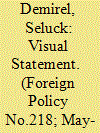

|
|
|
| 18 |
ID:
138754
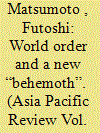

|
|
|
|
|
| Summary/Abstract |
The emergence of “Islamic State” or “Daesh”1 as abbreviation of “Islamic State in Iraq and al-Sham” in Arabic now poses a strategic challenge to the international community. Given a number of emerging issues such as “war” in the eastern states of Ukraine and assertive actions of China in East Asia, it requires a sober reflection on strategic thinking before embarking upon any tactical and operational measures vis-à-vis these challenges. This article treats the critical value of the Westphalian order based on a sovereign state system by distinguishing three challenges we face at this juncture: namely Daesh, Russia, and China and suggests ways to fight Daesh from a strategic point of view.
|
|
|
|
|
|
|
|
|
|
|
|
|
|
|
|
|
|
|
|
|